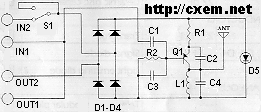
FM Telephone Bug

FM Telephone Bug. This is a simple transmitter that, when connected to a phone line, will transmit any audio on that line (except the dial tone) to any FM radio.
The FM Telephone Bug is designed to intercept and transmit audio signals from a telephone line. The circuit typically consists of a few key components: a microphone or audio pickup, an FM modulator, a power supply, and an antenna.
The audio signal is captured from the phone line and fed into the FM modulator, which converts the audio signal into an FM radio frequency signal. This modulation allows the audio to be transmitted over radio frequencies, which can then be received by any standard FM radio tuned to the appropriate frequency.
Power for the circuit can be derived from the telephone line itself or from an external battery source. It is crucial to ensure that the power supply used does not interfere with the normal operation of the telephone line. The antenna is typically a simple wire that is tuned to the frequency of transmission, allowing for effective broadcasting of the modulated signal.
The operational frequency can be adjusted based on the design of the FM modulator, which may include variable capacitors or inductors to fine-tune the output frequency. Proper shielding and grounding techniques should be employed to minimize interference and enhance signal clarity.
It is essential to note that the use of such devices may be subject to legal restrictions, as intercepting and transmitting telephone conversations without consent can violate privacy laws. Therefore, it is important to consider the legal implications of deploying an FM Telephone Bug in any application.FM Telephone Bug. Here is a simple transmitter that when connected to a phone line, will transmit anything on that line (execpt the dial tone) to any FM radio. The frequency. 🔗 External reference
The FM Telephone Bug is designed to intercept and transmit audio signals from a telephone line. The circuit typically consists of a few key components: a microphone or audio pickup, an FM modulator, a power supply, and an antenna.
The audio signal is captured from the phone line and fed into the FM modulator, which converts the audio signal into an FM radio frequency signal. This modulation allows the audio to be transmitted over radio frequencies, which can then be received by any standard FM radio tuned to the appropriate frequency.
Power for the circuit can be derived from the telephone line itself or from an external battery source. It is crucial to ensure that the power supply used does not interfere with the normal operation of the telephone line. The antenna is typically a simple wire that is tuned to the frequency of transmission, allowing for effective broadcasting of the modulated signal.
The operational frequency can be adjusted based on the design of the FM modulator, which may include variable capacitors or inductors to fine-tune the output frequency. Proper shielding and grounding techniques should be employed to minimize interference and enhance signal clarity.
It is essential to note that the use of such devices may be subject to legal restrictions, as intercepting and transmitting telephone conversations without consent can violate privacy laws. Therefore, it is important to consider the legal implications of deploying an FM Telephone Bug in any application.FM Telephone Bug. Here is a simple transmitter that when connected to a phone line, will transmit anything on that line (execpt the dial tone) to any FM radio. The frequency. 🔗 External reference





